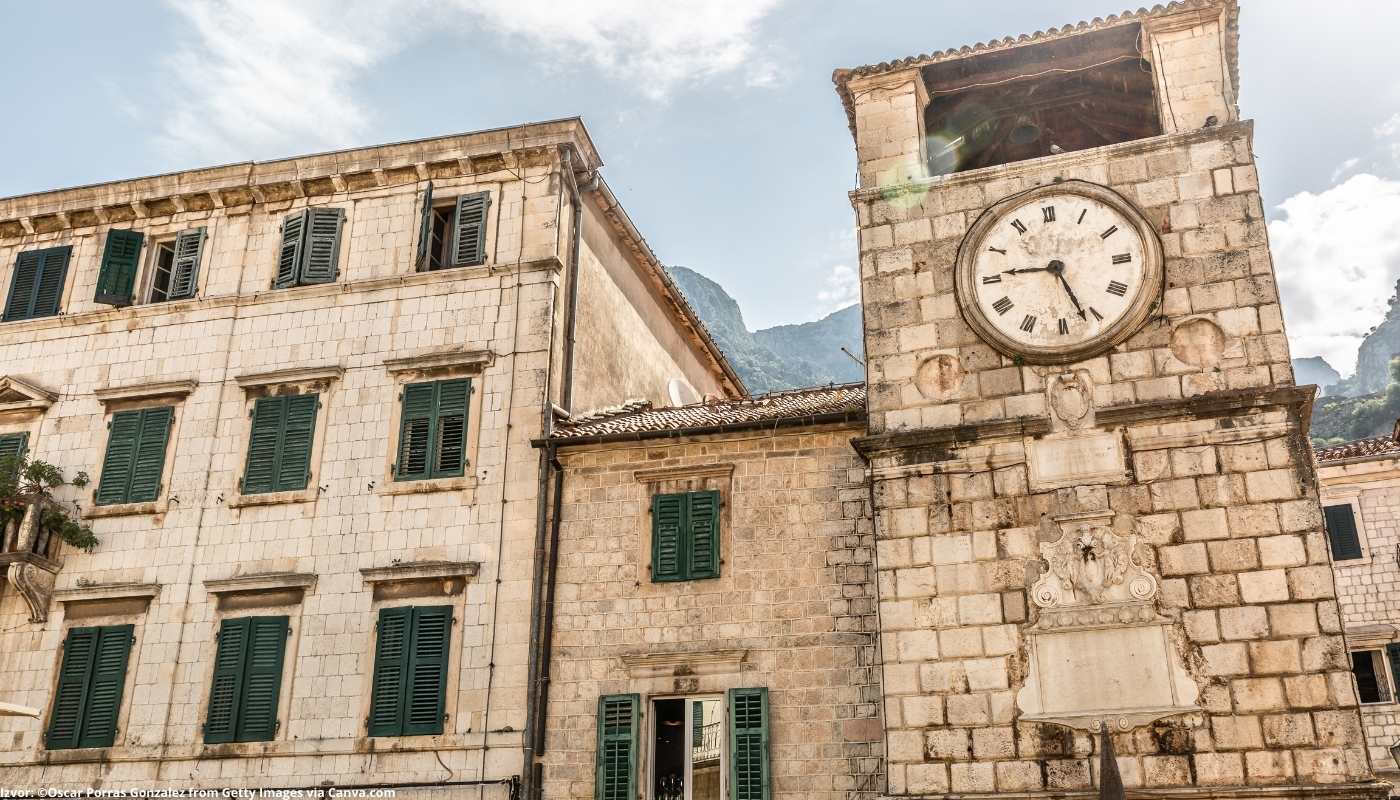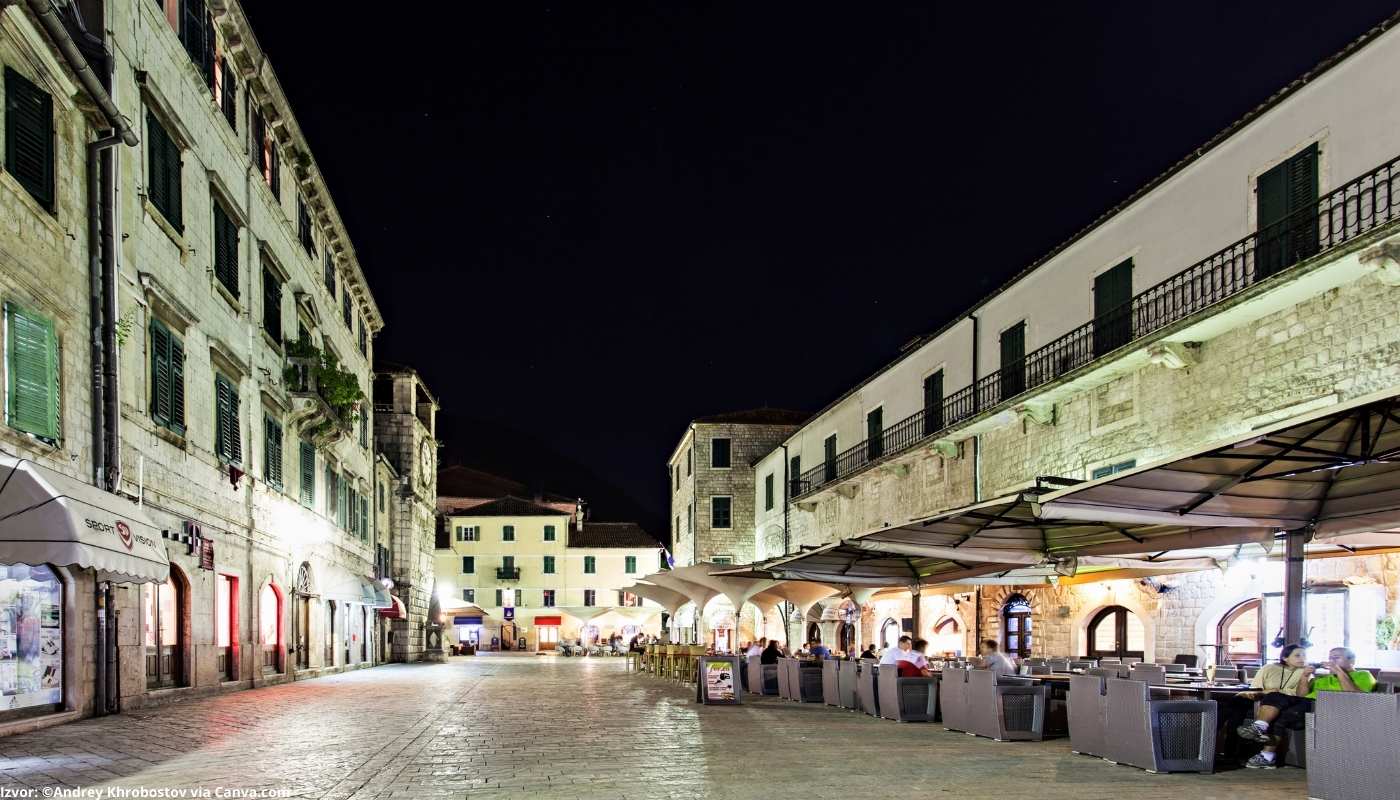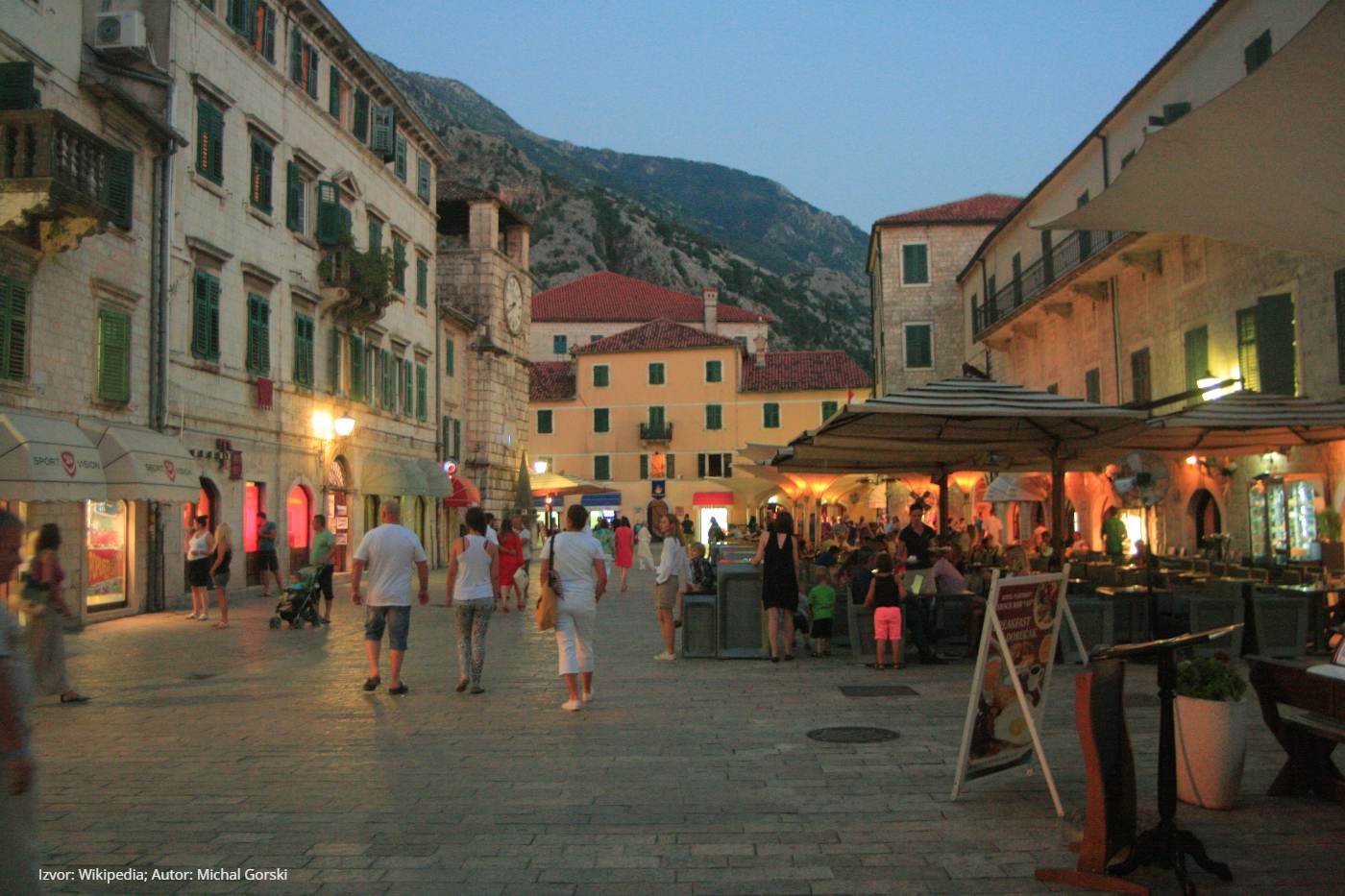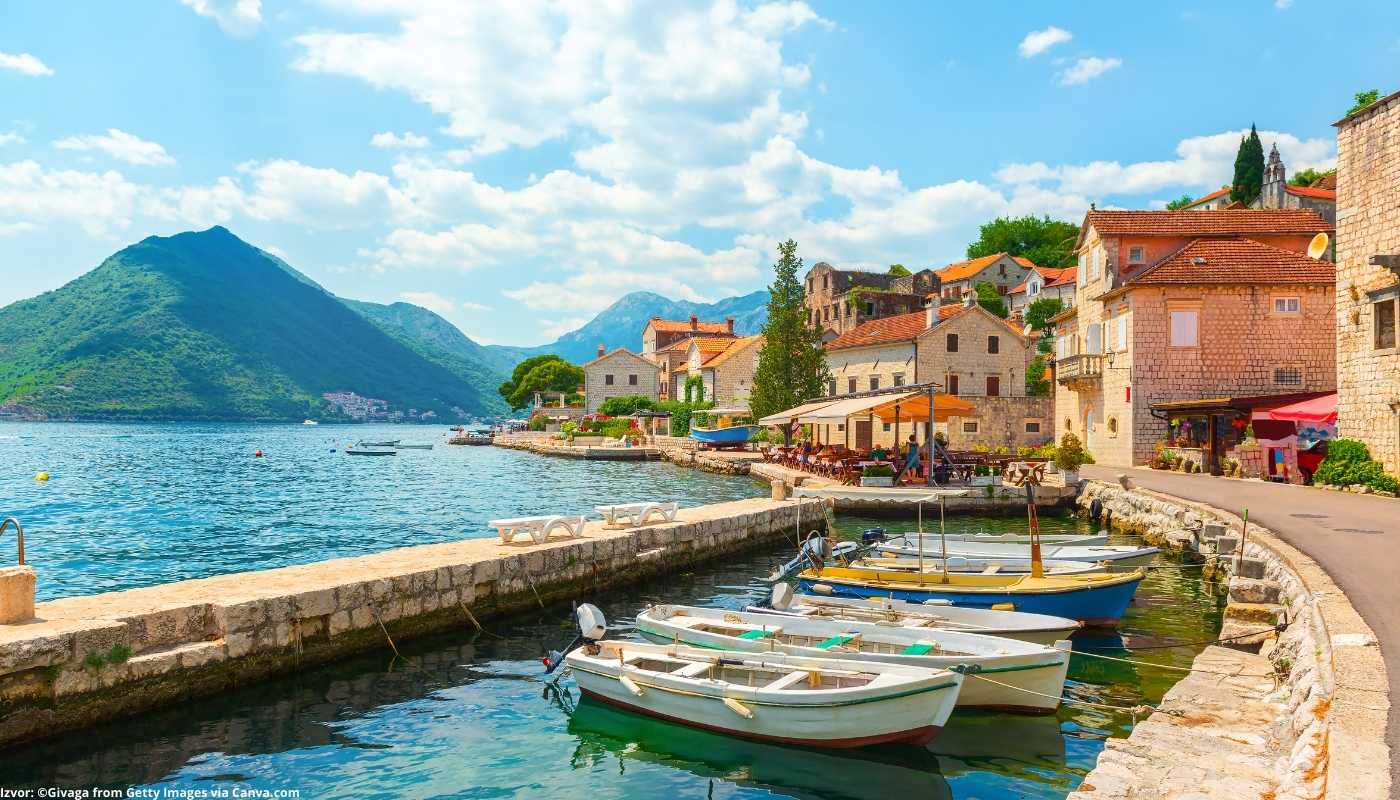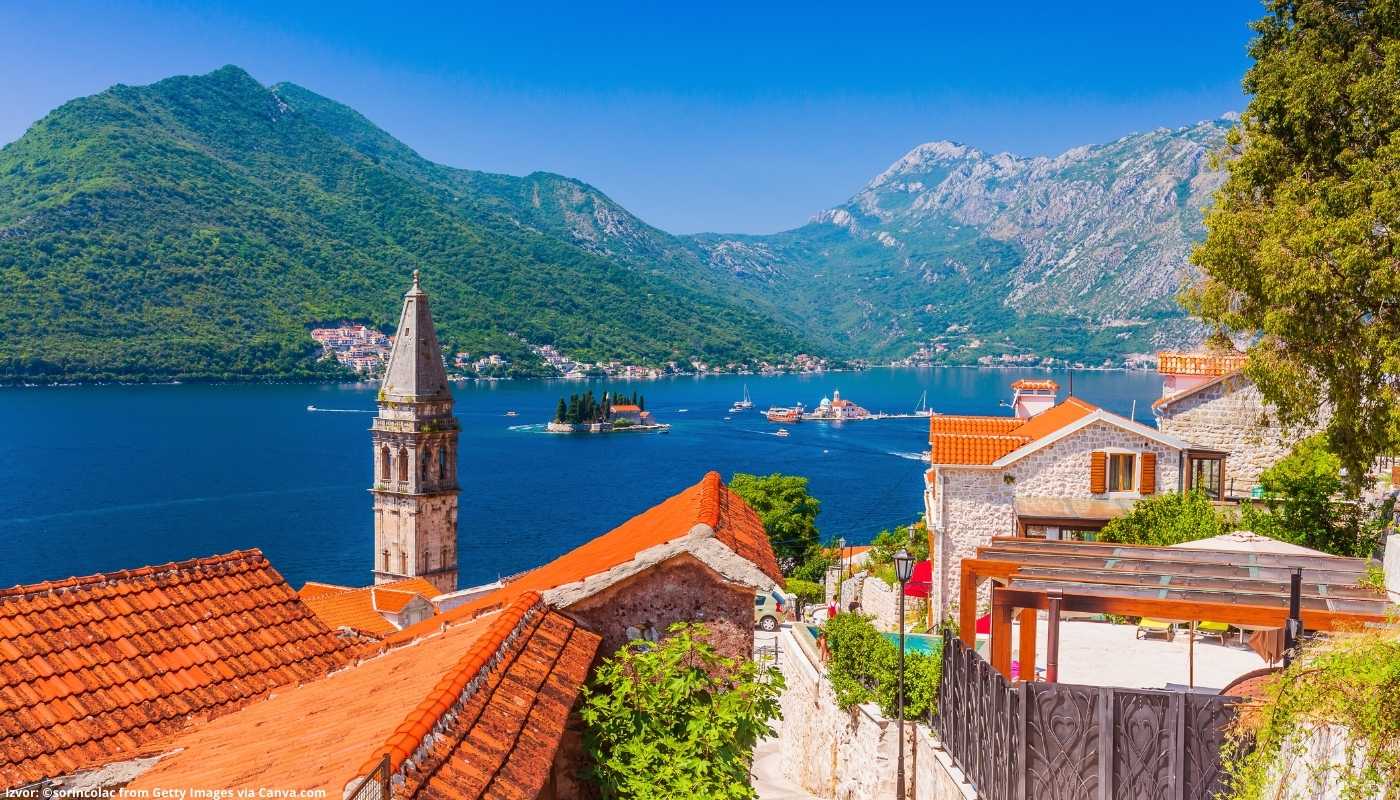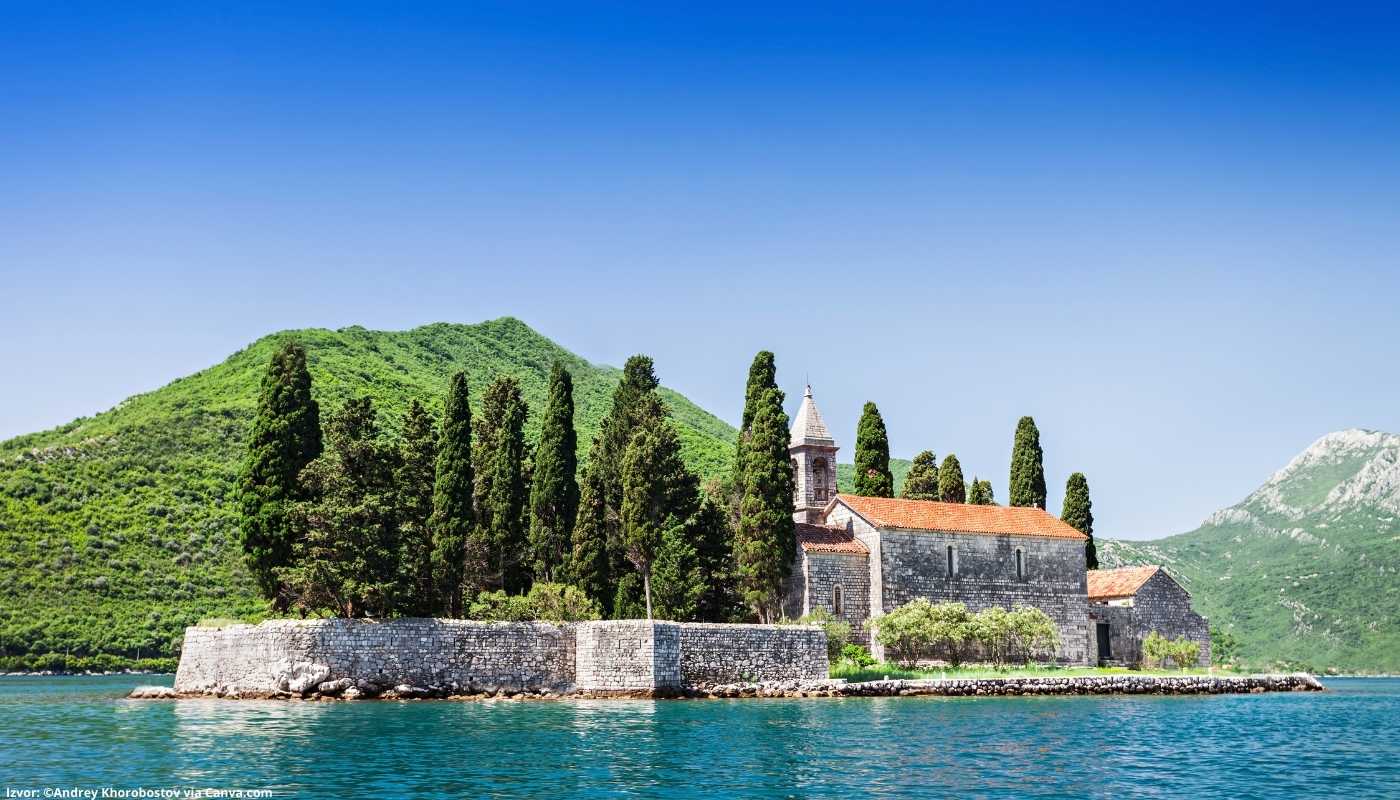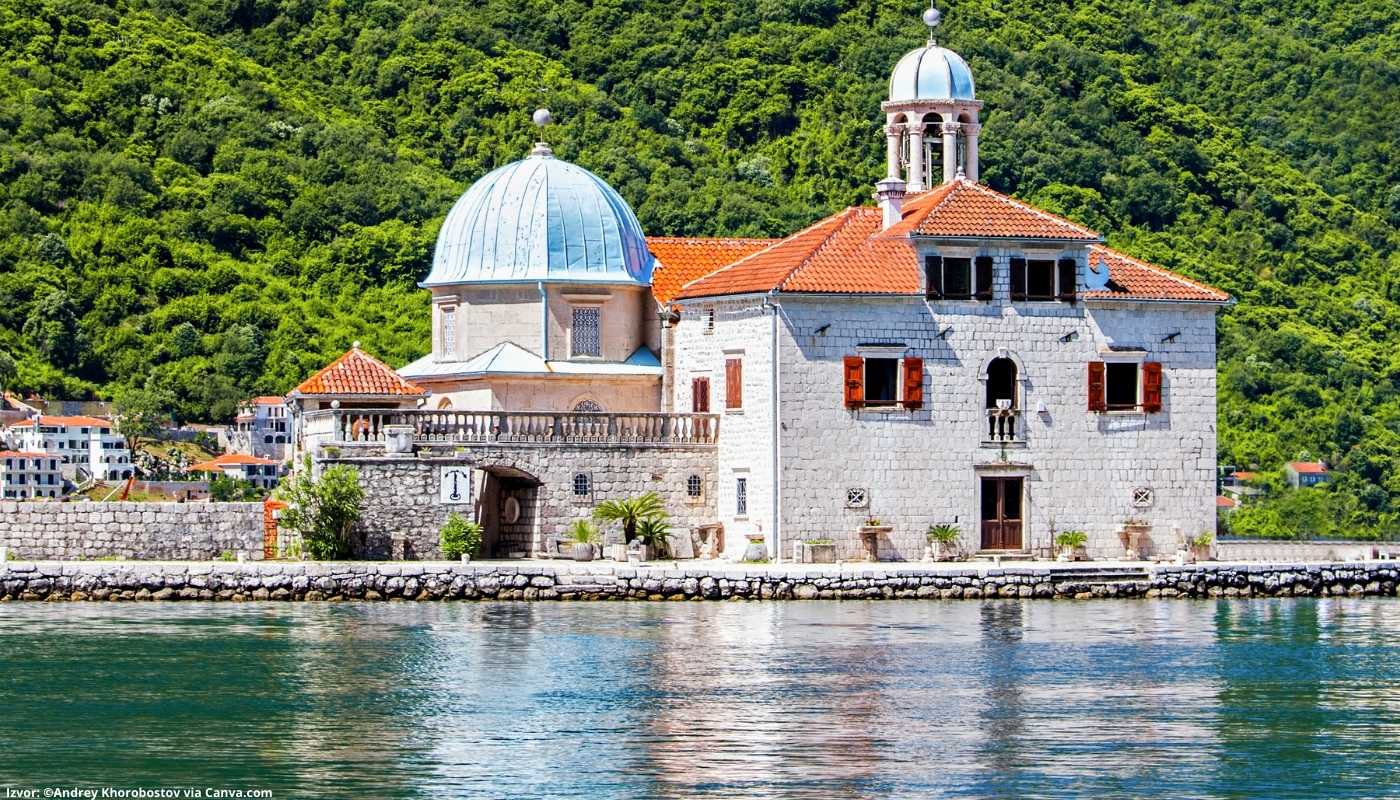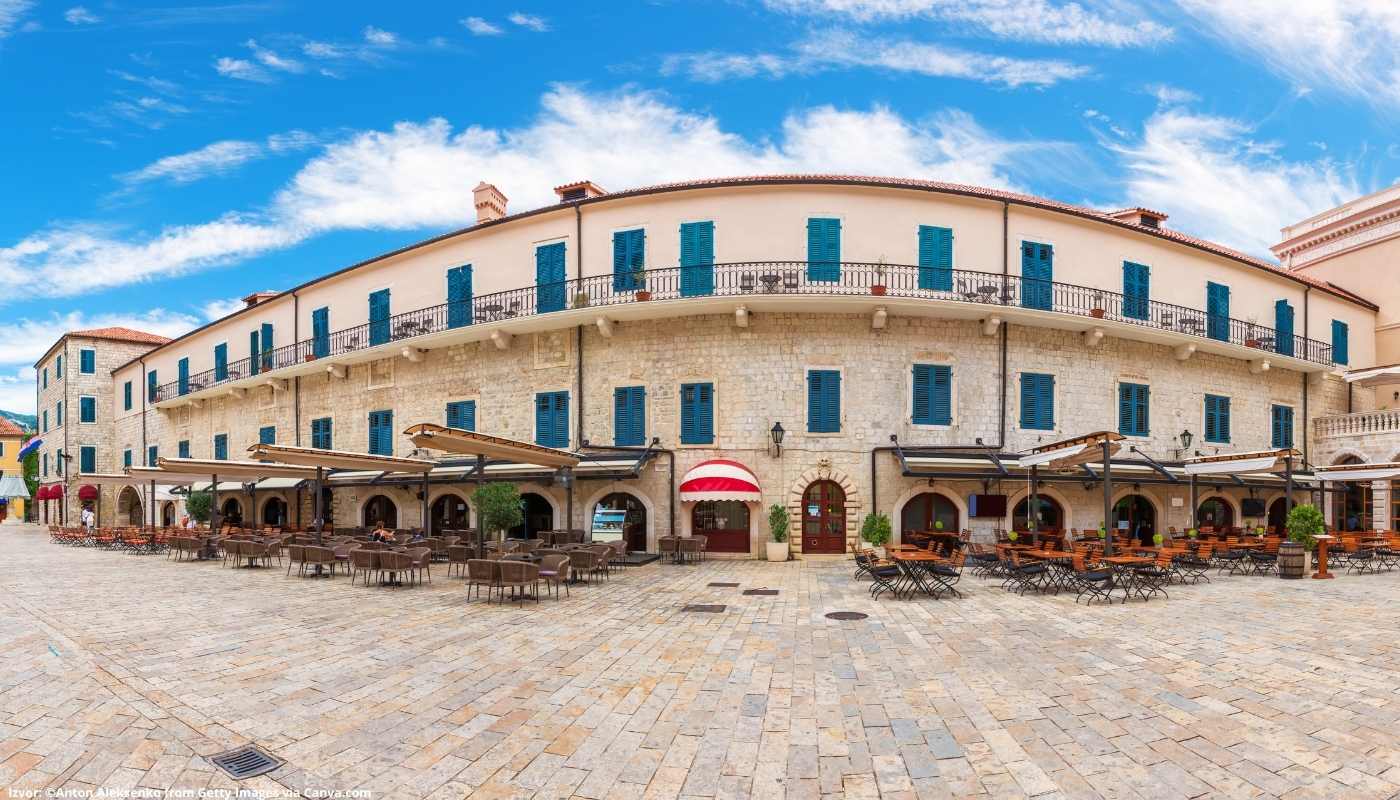When to visit Kotor?
- During spring - If you want to avoid the high temperatures and large crowds present during the summer season, April and May are ideal for going to Kotor and visiting all the sights in the city and its surroundings.
- During summer - If, however, you are in the mood to feel the real charm of the city in the period when it is most lively, the tourist season, which begins in mid-June and lasts until September, is the right choice for you.
How to reach Kotor?
- By plane - We recommend flying to the airport in Tivat, which is only 4.6 km from Kotor. Then you can get to Kotor by taxi at a price ranging between 6 and 8 euros. There is also a bus service, Globtour, which operates three times a day, from the Franca parking lot in Tivat to the Central Bus Station in Kotor. The price of a bus ticket ranges between 5 and 6 euros, and you can reach Kotor in just 20 minutes. Another Montenegrin airport is located in Podgorica, which is 39.5 km from Kotor.
- By boat - Kotor can also be reached by boat. Passenger and cargo ferries operate regularly on the Bar-Bari and Bar-Ancona lines. The ports of Bar, Budva, Kotor, and Herceg Novi have the status of ports for international traffic.
- By bus - Montenegro has the following border crossings: with Croatia - Debeli Brijeg; from BiH: Sitnica, Vilusi, Vracenovići, Scepan polje and Metaljka; with Albania: Bođaj, Sukobin. The following European corridors and their continuations lead through Montenegro: highway E-65/E-80 - (Croatia)-Igalo-Tivat-Budva-Petrovac na moru-Podgorica-Kolasin-Berane-Rozaje-(Serbia); main road E-762 - (Albania)-Bozaj-Podgorica-Niksic-Scepan Polje-(Bosnia and Herzegovina); highway E-763-(Serbia)-Bijelo Polje-Mojkovac-Kolasin; highway E-851-Petrovac na Moru-Bar-Ulcinj-(Albania).
- By train - there are railway stations in two Montenegrin cities, Bar and Podgorica. Montenegro has a railway connection with Albania and Serbia.
Tourist activities in Kotor
- Excursion to nearby places - for all lovers of relaxation, silence, and clean sea air, we recommend a trip to nearby, interesting places, such as Prcanj, Stoliv, Perast, and Risan. These towns are located in the Bay of Kotor, on both sides of the port of Kotor.
- Swimming pools - if you want to escape from the crowds on the sea beaches, there is an indoor, Olympic-sized pool at your disposal, a training place for the water polo club Primorac.
- Diving - there are many diving clubs in Kotor, and one of them is the Plava Planeta club. Feel free to surrender to the certified instructors and learn how to enjoy this relaxing activity. The phone number you can call and get information about the courses and their prices is +38267-358-500.
- Hiking - if you are a fan of active tourism, Kotor is the right destination for you. There is a trail above the town, ideal for all hiking enthusiasts. It leads to the Sveti Ivan peak, and then continues to the Krstac pass on the Lovćen mountain. Continue on foot towards Pestingrad or Jezerski vrh.
- Cruises - tourist boats, which are anchored in the port of Kotor during the summer season, offer full-day cruises in the Bay of Boka Kotor. If you decide on this type of activity, you will get a unique opportunity to see one of the most beautiful fjords in the world. Ave Tours is a well-known agency that offers full-day Boka cruises. The excursion lasts 12 hours, and a group of 6 people is required for its realization. The price per person is 55 euros.
Events and festivals in Kotor
- Kotor Carnival - this type of manifestation, under the original name Festanje, is held twice a year, in February and August. The festival is attended by over a thousand visitors every year. Traditionally, the February carnival welcomes and greets the new spring and is held during daylight hours until sunset. The summer carnival has an international character, and tourists can attend a large number of festive activities in the pleasant evening hours. Original masks are prepared for this type of celebration, and competitions are also held. The best carnival group receives a prize in the form of a certain amount of money. The carnival is accompanied by other events, especially for children, when different masquerade balls are held. The procession passes along the entire Kotor waterfront.
- Bokeljska night - the event is traditionally held in the second half of August and is a parade of masked boats. In the evening hours, visitors have the opportunity to attend a creative masquerade of boats, the aim of which is to show coastal life and mentality, but also to portray certain social phenomena in a completely original and, sometimes, comical way. Traditionally, the end of this festive event is accompanied by fireworks.
- Tripunda festivities - is a traditional festival and of great importance for the city of Kotor because festivities are held in honor of St. Trifun, Kotor's patron saint. The event begins with a circle of the Bokelj Navy in front of the Cathedral of St. Trypun, followed by a mass and then a procession through the city. Choral, musical, and folklore ceremonies are also performed.
- Camellia festivals - an event in Kotor during which exhibitions of camellia flower arrangements, art workshops, and exhibitions in nature are traditionally held. The festival is accompanied by a cultural and entertainment program and a ball at which the camellia lady is chosen.
Activities for children in Kotor
- The Kotor Children's Theater Festival - founded in 1993, is traditionally held in the first half of July, more precisely, in the first 12 days of July. The goal of the festival is to entertain the youngest, as well as encourage and affirm artistic creation and creativity in children and youth.
- City park - a place where the little ones can have fun, and there are ice cream and cake shops nearby.
- Museum of cats - over time, cats have become a symbol of Kotor, so the city decided to dedicate a museum to them. This attraction is especially interesting for little ones, and the museum gives them the opportunity to send a picture of their pet, so their cats can become permanent members of this unusual sight.
What to see in Kotor?
- The old town of Kotor is the part of Kotor that gathers the largest number of tourists both during and outside the tourist season. Medieval architecture - churches, palaces, cathedrals, and museums make it particularly attractive. Allow yourself to get lost in one of the narrow, cobbled streets - you will come to the most beautiful squares and staircases, and you will have the opportunity to see the palaces of wealthy families from various historical eras.
- The Cathedral of St. Trypun - the heart of the old core of Kotor is a cathedral dedicated to the city's patron saint, St. Trypun. The cathedral dates back to the 13th century and is also the most famous Kotor monument.
- The Arms square - it is the main and the biggest and the scene of a large number of festivals and events. It is a unique combination of traditional and modern elements. Namely, it is adorned with countless restaurants and cafes, but you can also feel the omnipresent spirit of history. It got its name during the Venetian rule when weapons were made and repaired there.
- Maritime Museum - located in the Baroque palace, Grgurina, which dates back to the 18th century. It is located on the Bokelj Navy Square and is significant because, in addition to its museological role, it also has a cultural and educational character. It hosts book promotions, exhibitions, and musical performances and attracts a large number of visitors every year.
- St. Ivan Fortress - another unmissable attraction for every visitor to Kotor is the fortress located above the ramparts of Kotor's old town. Among the people of Kotor, it is also known as San Giovanni. Serpentines lead to the fortress, which starts at the eastern part of the old town of Kotor and climbs to the top of the fortress, at 280 meters above sea level.
Accommodation in Kotor
- Hotels - if you decide on a more luxurious and expensive type of accommodation, there are hotels in Kotor that have their own parking lots, open and closed swimming pools, and various types of recreation rooms. Hotels located right next to the seashore also have their own improvised, rocky beaches. Some of the more famous hotels in Kotor are Teuta, Fjord, Vardar, and the famous Splendido. It is located in Prcanj and has four stars, and the price of a night in this type of hotel is around 150 euros.
- Apartments - if you have decided on more affordable accommodation, apartments in Kotor are the right choice for you. We will give you some of the names of the apartments - Apartment Laki, Apartment Ana Paola, and Apartment Dakovic. The price per night for this type of accommodation starts from 20 euros per night.
Phone numbers for important services in Kotor
- Police department - 122
- Firefighters - 123
- Emergency service - 124
- Municipality of Kotor - 325 - 869, 325 -868
- Municipal police - 325-860
- Tourist organization Kotor - 322-886
- Health center -334 -533
- Kotor General Hospital - 325 - 595
- Bus station - 325 - 809
Where to eat in Kotor?
- Restaurant Galion - a 5-minute walk along the coast from the Old Town, there is a restaurant with an open terrace in summer and a glazed terrace in winter. It is famous for its excellent seafood specialties, including octopus salad, homemade gnocchi, and all kinds of fresh grilled fish.
- Tavern Scala Santa - located in the heart of the Old Town. It is the right choice for all lovers of culinary specialties. It is famous for fresh grilled fish with the obligatory olive oil and lemon. If you are a visitor to Kotor at the height of the tourist season, you will have the opportunity to sit at one of the tables on the stone slabs in the square itself.
- Restaurant Ellas - is located in Dobroti, at a distance of 3 kilometers from the center of Kotor. You will be delighted with the authentic fisherman's interior, the terrace covered with vines and fishing nets. The restaurant has a beautiful view of the bay. We recommend dried fruit in honey or pancakes in white wine to all those with a sweet tooth.
- Café-pizzeria Mondo - located in Dobrota, overlooking Boka. The pizzeria has a large selection of quality food and drinks.
Transportation and taxi services in Kotor
- Public transport: The city carrier BLUE LINE runs daily from Kotor bus station.
- Taxi: Taxi services are also available in Kotor, so below are the phone numbers of the taxi stations: Red Taxi-19719; Gir Taxi-19737; Vip Taxi-19757; Euro Taxi -19708
Parking in Kotor
- Parking Benovo
- Parking Putsch
- Parking Riva
- Autoboka parking
Surroundings of Kotor
- Dobrota - it is located in the immediate vicinity of the town of Kotor, and it can be reached with a leisurely walk along the seashore. It is the most populous settlement in the municipality of Kotor and extends all the way to the settlement of Ljuta.
- Perast is a city settlement in the Municipality of Kotor and is located at the foot of the Sveti Ilija hill. You can get from Kotor to Perast by car in 15 minutes. One long street leads along the entire coast, and from it, stairs lead to higher parts of the city. It is an extremely quiet town that captivates with its architecture and the square dominated by the church of St. Nikola.
- The island of Gospa od Skrpjela - is located near Perast, and the fastest and easiest way to get to the island from this small town is by boat. According to legend, the sailors found an icon of Our Lady with the Child on the rock and decided to build a small chapel there. Traditionally, at the end of a successful voyage, people came to the island and left stones, so the surface of the island grew over time.
- Prcanj - a place with small, mostly concrete beaches. It is widely known for its curative air currents and is intended for everyone who wants to spend a quiet and intimate vacation.
- Risan - is the oldest settlement in this region, known for its Roman mosaics. It is located just a few kilometers from Perast, and you can feel the real Montenegrin spirit in it.
History of Kotor
- Origin of Kotor - Certain data indicate that Kotor was inhabited during the time of ancient Rome and was part of the Roman province of Dalmatia. However, in other sources, you can find information that Kotor is even two millennia old and that it comes from the word Decatera (katareo-spring). The strong ramparts that surround the city were built during the reign of the Byzantines, Nemanjic, and the Venetians.
- Rules throughout history - The rich culture of today's Kotor is also attributed to the succession of many peoples who ruled this city. Namely, in historical sources, you can find information about the rule of the Illyrians, Byzantines, Hungarians, Venetians, French, and Austro-Hungarians. The city was first ruled by the Illyrians, but the founders of Kotor are considered to be the Romans. The Nemanjic dynasty gave the city the name Kotor, made it the main seaport, and maintained connections with the west through it. During the reign of the Nemanjic dynasty, Kotor experienced a significant economic and cultural boom.
Geography and climate in Kotor
- Geography - Kotor is located in the southeastern part, at the very end of the Boka Kotor Bay. It is located on the alluvium of the river Skurda, which flows along its northern walls, and the spring of Gudric, which springs from its southern walls. It is surrounded by the mountain Lovcen and the hill Sveti Ivan.
- Climate - Kotor and its surroundings have a typical Mediterranean climate characterized by hot and dry summers and mild and wet winters. The average annual temperature is 15.2° C. The warmest month is July, with an average air temperature of 24.1° C and a sea temperature of 23.0° C. The average January air temperature is 7.7° C, and the sea temperature is 13. 1° C.
Demographics of Kotor
- Montenegrins - 48.88%
- Serbs - 30.57%
- Croats - 6.67%
- Other/undeclared - 13.68%
Tradition and culture of Kotor
- Culture - Traces of Illyrian and Roman culture, pre-Romanesque, Romanesque, Gothic, Renaissance and Baroque have been preserved in Kotor. Its medieval urban complex is considered one of the best preserved, so Kotor is included in the list of world cultural heritage and is under the protection of UNESCO.
- Prominent personalities - In the Middle Ages, Greek painters created in Kotor, among them Nikola and Manojlo at the beginning of the 14th century. The famous shopkeeper Marin Drusko and the famous merchant and captain Marko Grgurovic lived in Kotor. The names of Djordje Bizanti and Ludovic Paskvalic are associated with Kotor literature.
- Tradition - The centuries-old tradition of the city, interwoven narrow streets, churches, old buildings and walls with traces of two thousand years of history present for every visitor a magical and unrepeatable experience, and often the feeling that they have found themselves in a real time machine.





















